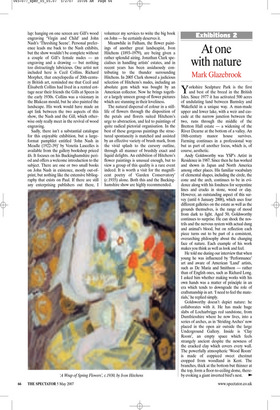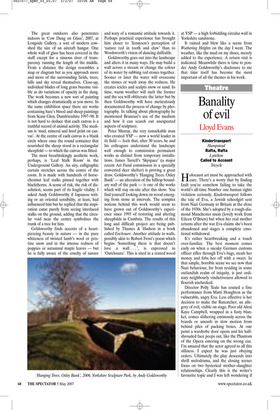At one with nature
Mark Glazebrook
Yorkshire Sculpture Park is the first and best of the breed in the British Isles. Since 1977 it has activated 500 acres of undulating land between Barnsley and Wakefield in a unique way. A man-made upper and lower lake, with a weir and cascade at the narrow junction between the two, runs through the middle of the Bretton Hall estate — a widening of the River Dearne at the bottom of a valley. An 18th-century manor house survives. Farming continues in a professional way but as part of another focus, which is, of course, aesthetic.
Andy Goldsworthy was YSP’s Artist in Residence in 1987. Since then he has worked and shown in Japan and North America among other places. His familiar vocabulary of elemental shapes, including the circle, the cone and the arch, continues to be in evidence along with his fondness for serpentine lines and cracks in stone, wood or clay. However, an outstanding aspect of this survey (until 6 January 2008), which uses four different galleries on the estate as well as the grounds themselves, is the range of mood from dark to light. Aged 50, Goldsworthy continues to surprise. He can shock the nostrils and the nervous system with actual dung and animal’s blood, but on reflection each piece turns out to be part of a consistent, overarching philosophy about the changing face of nature. Each example of his work makes you think as well as look and feel.
He told me during our interview that when young he was influenced by ‘Performance’ art and aware of American ‘Land’ artists, such as De Maria and Smithson — rather than of English ones, such as Richard Long. I asked him whether making works with his own hands was a matter of principle in an era which tends to downgrade the role of craftsmanship in art. ‘I need to feel the materials,’ he replied simply.
Goldsworthy doesn’t depict nature: he collaborates with it. He has made huge slabs of Locharbriggs red sandstone, from Dumfriesshire where he now lives, into a series of arches, as in ‘Striding Arches’ now placed in the open air outside the large Underground Gallery. Inside is ‘Clay Room’, an empty space which feels strangely ancient despite the newness of the cracked clay which covers every wall. The powerfully atmospheric ‘Wood Room’ is made of coppiced sweet chestnut cropped from woodland in Kent. The branches, thick at the bottom but thinner at the top, form a floor-to-ceiling dome, thereby evoking a giant inverted bird’s nest. The great outdoors also penetrates indoors in ‘Cow Dung on Glass’, 2007, at Longside Gallery, a sort of modern cowshed the size of an aircraft hangar. One whole wall of glass has been covered in the stuff except for a sinuous river of transparency running the length of the middle. From a distance the design resembles a map or diagram but as you approach more and more of the surrounding fields, trees, hills and sky reveal themselves. Close-up, individual blades of long grass become visible as do variations of opacity in the dung. The work becomes a new sort of painting which changes dramatically as you move. In the same exhibition space there are works containing hare’s blood and sheep paintings from Scaur Glen, Dumfriesshire 1997–98. It is not hard to deduce that each canvas is a truthful record of animal activity. The medium is ‘mud, mineral and hoof print on canvas’. At the centre of each canvas is a blank circle where once the round container that nourished the sheep stood in a rectangular sheepfold — to which the canvas was fitted.
The most breathtakingly aesthetic work, perhaps, is ‘Leaf Stalk Room’ in the Underground Gallery. An airy, calligraphic curtain stretches across the centre of the room. It is made with hundreds of horsechestnut leaf stalks pinned together with blackthorns. A sense of risk, the risk of dissolution, seems part of its fragile vitality. I asked Andy Goldsworthy if Japanese writing or an oriental sensibility, at least, had influenced him but he replied that the inspiration came purely from seeing interlaced stalks on the ground, adding that the circular void near the centre symbolises the trunk of a tree for him.
Goldsworthy finds accents of a heartpiercing beauty in nature — in the pure whiteness of twisted lamb’s wool or pristine snow and in the intense redness of poppies or autumnal maple leaves — but he is fully aware of the cruelty of nature and wary of a romantic attitude towards it. Perhaps practical experience has brought him closer to Tennyson’s perception of ‘nature red in tooth and claw’ than to Wordsworth’s vision of dancing daffodils.
Goldsworthy goes out into the landscape and alters it in many ways. He may build a wall across a stream or change the colour of its water by rubbing red stones together. Sooner or later the water will overcome the stones or wash away the redness. He creates icicles and sculpts snow or sand. In time, warm weather will melt the former and the sea will obliterate the latter but by then Goldsworthy will have meticulously documented the process of change by photography. In talking about photography he mentioned Brancusi’s use of the medium and how it can search out unexpected aspects of sculpture.
Peter Murray, the very remarkable man who created YSP — now a world leader in its field — feels that, after 30 years, he and his colleagues understand the landscape well enough to commission permanent works as distinct from temporary installations. James Turrell’s ‘Skyspace’ (a major recent Art Fund commission in a specially converted deer shelter) is proving a great draw. Goldsworthy’s ‘Hanging Trees. Oxley Bank’ — an alteration of the hilltop boundary wall of the park — is one of the works which will stay on-site after this show. You find yourself looking down on wood emerging from stone at intervals. The complex notions behind this work would seem to have grown out of Goldsworthy’s experience since 1995 of restoring and altering sheepfolds in Cumbria. The results of this long and difficult project are being published by Thames & Hudson in a book called Enclosure. Another attitude to walls, possibly akin to Robert Frost’s poem which begins ‘Something there is that doesn’t love a wall ... ’, is expressed in ‘Outclosure’. This is sited in a rented wood at YSP — a high forbidding circular wall in Yorkshire sandstone.
It rained and blew like a scene from Wuthering Heights on the day I went. The weather, like the mud on my shoes, merely added to the experience. A return visit is indicated. Meanwhile there is time to ponder Andy Goldsworthy’s disclosure to me that time itself has become the most important of all the themes in his work.



































































































 Previous page
Previous page